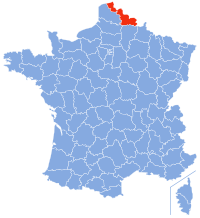Nord (department)
| Nord | |
|---|---|
 |
|
| Coat of arms of the Nord department | |
| Location | |
 |
|
| Administration | |
| Department number: | 59 |
| Region: | Nord-Pas-de-Calais |
| Prefecture: | Lille |
| Subprefectures: | Avesnes- sur-Helpe Cambrai Douai Dunkirk Valenciennes |
| Arrondissements: | 6 |
| Cantons: | 79 |
| Communes: | 652 |
| President of the General Council: | Bernard Derosier |
| Statistics | |
| Population | Ranked 1st |
| -Jan.1, 2006 estimate -Mar.8, 1999 census |
2,583,493 2,555,020 |
| Population density: | 450/km² |
| Land area¹: | 5,743 km² |
| ¹ French Land Register data, which exclude estuaries, and lakes, ponds, and glaciers larger than 1 km². | |
Nord (English: North) is a department in the far north of France. It is the country's most populous department.
Contents |
History
Nord was one of the original 83 departments that were created during the French Revolution on March 4, 1790. It was made up of three regions: the Spanish Netherlands Counties of Flanders and Hainaut, and the Bishopric of Cambrai, which were ceded to France in successive treaties (1659, 1668, and 1678).
During the 4th and 5th centuries, the Roman practice of coopting Germanic tribes to provide military and defense services along the route from Boulogne to Cologne created a Germanic-Romance linguistic border in the region that persisted until the 8th century. Saxon colonization into the region from the 5th to the 8th centuries likely extended the linguistic border somewhat south so that by the 9th century most inhabitants north of Lille spoke a dialect of Middle Dutch, while the inhabitants to the south spoke a variety of Romance dialects. This linguistic border is still evident today in the place names of the region. After the 9th century, the linguistic border began to shift north and east, a process accelerated by modern government policies that recognize French as the country's official language. There are currently 20,000 speakers of a subset of the Dutch dialect West Flemish in the arrondissement of Dunkirk and this particular subset is in danger of extinction within decades.[1]
Geography
Nord is part of the current Nord-Pas-de-Calais region and is surrounded by the French departments of Pas-de-Calais and Aisne, as well as by Belgium and the North Sea.
Situated in the north of the country along the western half of the Belgian frontier, the department is unusually long and narrow. Its principal city is Lille, which with nearby Roubaix, Tourcoing and Villeneuve d'Ascq constitutes the center of a cluster of industrial and former mining towns totalling slightly over a million inhabitants. Other important cities are Valenciennes, Douai, and Dunkirk. The principal rivers are the following:
- Yser
- Lys
- Escaut
- Scarpe
- Sambre
Economy
At the forefront of France's 19th century industrialisation, the area suffered severely during World War I and now faces the economic, social and environmental problems associated with the decline of coal mining with its neighbours following the earlier decline of the Lille-Roubaix textile industry.
Until recently, the department was dominated economically by coal mining, which extended through the heart of the department from neighbouring Artois into central Belgium.
Demographics
Nord is the most heavily populated department, with a population of 2,583,493 and an area of 5,743 km².
See also
- Cantons of the Nord department
- Communes of the Nord department
- Arrondissements of the Nord department
- French Flemish
References
- ↑ Dutch dialectPDF (404 KB)
External links
- (French) Prefecture website
- (French) General Council website
- (English) Nord Tourism Guide
- (English) links DMOZ
|
|||||